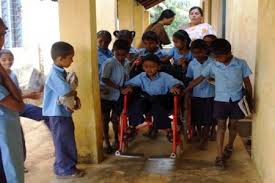Anjum (name changed), aged five, from KR Puram, is special. She suffers from a physical disability which has left her with tiny hands joined. Born to
a disabled father and into a poor household, little did she imagine that she would go to school or hold a textbook in her hands.
NGOs came to her rescue and worked hard to get her enrolled under the Right to Education (RTE) quota at a private school in Devasandra. Taufiq (name changed), an orphan, too was enrolled along with her.

But not all children are as lucky as these two.
A study has found that disadvantaged children living with HIV and those with disabilities face discrimination at schools and the Education Department as a majority of RTE seats are taken by children from scheduled castes and tribes and other backward classes.
The study covered 36 unaided schools in Bangalore North and Bangalore South and 16 in Delhi.
The study, titled ‘Inclusion of Marginalised Children in Private Unaided Schools under the RTE Act, 2009: An Exploratory Study’, has been brought out by rights group Oxfam India. It notes that the problem stems from the fact that neither does the Department of Public Instruction (DPI) maintain records on such disadvantaged children being admitted under the RTE, nor do schools indicate such admissions.
Left in the Lurch
Anjum and Taufiq belong to a very small per cent of kids who have made it to schools, says Premalatha, who works at the Association for Promotion of Social Action (APSA).
The study says that certain disadvantaged groups such as children with disabilities have been left out in the larger pool of disadvantaged children. Orphans, street and migrant children and those with HIV are not included. But SC, ST and OBC children have benefited from this quota, with OBCs availing the most number of seats.
This Seat is Taken
Student enrolment under RTE last year paints a different picture. Of the 17,011 kids enrolled in 1,927 schools in Bangalore North and South, 69 per cent belonged to the OBC category, 28 per cent to SC and the rest ST.
Rao said even the lottery process, conducted by schools that have surplus RTE applications, is not done in a fair manner for these kids. “While drawing lots, schools use only three categories — SC, ST and OBC. So we don’t really know where these disadvantaged kids figure,” he said.
Problem of Multiple Disadvantages
In fact, the study points out that there is an emerging issue of ‘multiple disadvantages’ as the definition of ‘disadvantaged’ doesn’t account for the complex multiple disadvantages existing on ground, for eligibility under RTE Act.
According to a government order dated March 18, 2013, 16 per cent of seats of the 25 per cent quota are earmarked for children from disadvantaged and weaker sections (including OBCs), while 7.5 per cent is for SC and 1.5 per cent for ST.
DPI statistics reveal that not a single child from this disadvantaged group was admitted under RTE Act in unaided schools. Meanwhile, only 69 children found seats in 5,790 aided schools across the state.
HIV: Acceptance a Distant Dream
Ashok K Rau, executive trustee and CEO of Freedom Foundation, said the fact that RTE scheme was biased against children with HIV is not a surprise. He said despite initiatives, there is very little acceptance.
“Kids living with HIV have never been reckoned as children who need to benefit from these initiatives. HIV positive children who are enrolled in schools get thrown out. Stigma ensures they are pulled out,” Rau said.
The trouble starts with the school management and the Education Department officials, he noted. When NGOs approach schools for admissions, they immediately reply in the negative. “The reasons they give are that parents of other children will object when their kids have to study with HIV positive children. They also said it may affect the image of the school.”
Meanwhile, Sheila Devaraj, director of APSA, said a very small percentage of street children actually benefit from the RTE Act and that too only after they hide the fact that they are from the streets.
OFFICIALSPEAK
Commissioner for Public Instruction Mohammad Mohsin refuted the study’s observation of discrimination against the disadvantaged. “If you look at our reservation policy, we have earmarked seats for these children. It is just that there is very little demand. This year, however, I am confident that the situation will be better for such children. We received 3.8 lakh applications for 1.8 lakh seats,” Mohsin said.
WHO ARE THE DISADVANTAGED
The disadvantaged group includes orphans, HIV+ kids, those with special needs, migrant and street children
HIGHLIGHTS OF THE REPORT
■ Majority of RTE seats taken by SC, ST and OBC.
■ HIV+ and disabled children face bias
■ No records of these kids’ admissions under RTE
■ A separate category for the disadvantaged is absent
■ Only 69 disadvantaged children found seats in 5,790 aided schools across state
■ None admitted in unaided schools
Date: 07th April, 2014
Source: IndianExpress